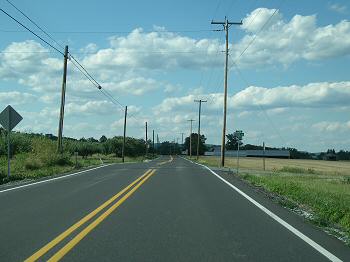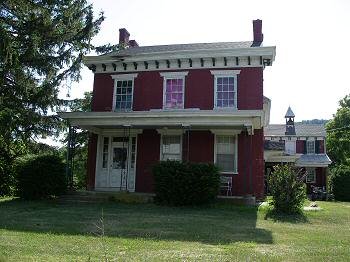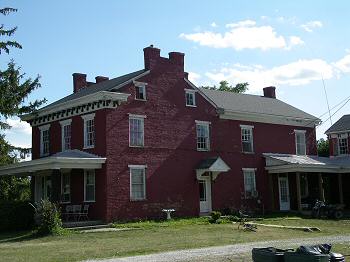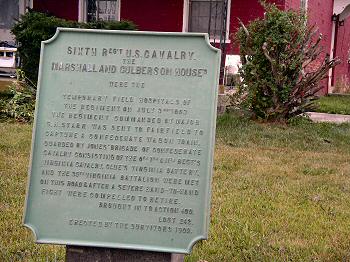|
During the Gettysburg Campaign in the
American Civil War, the Battle of Fairfield played an important role in
securing the Hagerstown Road, enabling Robert E. Lee's Army of Northern
Virginia to retreat through Fairfield towards the Potomac River.
Union Hospital 17, the Hugh Culbertson Farm: "Situated on Carroll's Tract
Road between Cashtown and Fairfield, this house was used as a hospital for
the 6th Cavalry. On July 3, 1863, the rear guard of the Confederate
Cavalry and the 6th Union Cavalry skirmished in this area. Private George
Platt, Troop II, of the 6th Cavalry saved the Union Colors, was promoted
to Sergeant, and awarded the Medal of Honor."
The Battle of Fairfield was a cavalry engagement during the Gettysburg
Campaign of the American Civil War. It was fought July 3, 1863, near
Fairfield, Pennsylvania, concurrently with the Battle of Gettysburg,
although it was not a formal part of that battle. While a minor fight by
the small number of troops deployed, strategically, the Confederate
victory secured the important Hagerstown Road, which Robert E. Lee's Army
of Northern Virginia would use on July 5 to return to Maryland and then on
to safety in Virginia.
Much of the cavalry of the Army of Northern Virginia had accompanied J.E.B.
Stuart on his ride around the Federal Army of the Potomac through Maryland
and south-central Pennsylvania. Lee had retained several brigades to guard
the mountain passes as he advanced through the Shenandoah and Cumberland
Valleys and to scout Federal positions. Among the latter brigades was that
of William E. "Grumble" Jones�the celebrated "Laurel Brigade" that had
once been commanded by Turner Ashby. Jones had detached one of his best
commands, the 35th Battalion, Virginia Cavalry, to accompany the infantry
of Jubal Early, but retained the bulk of his command. Jones' Brigade had
been raiding the Baltimore & Ohio Railroad in West Virginia and Maryland
before being recalled by Lee. They hastened to Pennsylvania, crossing the
Potomac River on July 1 (where Jones detached the 12th Virginia to guard
the ford) and camping at Chambersburg the following night.
Jones' force had been reduced to the 6th, 7th, and 11th Virginia Cavalry
and Preston Chew's Battery of horse artillery. Jones reached Fairfield on
July 3 in response to Lee's orders to secure the vital Hagerstown Road.
Reports of a slow moving Confederate wagon train in the vicinity had
attracted the attention of newly commissioned Union Brig. Gen. Wesley
Merritt, who ordered the 6th U.S. Cavalry under Maj. Samuel H. Starr to
scout Fairfield and locate the wagons.
Once in Fairfield, Major Starr learned that a wagon train had just rolled
out of town and was heading to Cashtown. He divided his 400 men into three
detachments and began to search for the wagons. One party soon encountered
the pickets of Jones' 7th Virginia Cavalry and withdrew when additional
Confederates rode up. Informed of the presence of the enemy, Starr rode to
a small ridge and dismounted his men in fields and an orchard on both
sides of the road. He threw back a mounted charge of the 7th Virginia,
just as Chew's Battery unlimbered and opened fire on the Federal
cavalrymen. Supported by the 6th Virginia, the 7th Virginia charged again,
clearing Starr's force off the ridge and inflicting heavy losses. Jones
pursued the retreating Federals for three miles to the Fairfield Gap, but
was unable to catch his quarry.
Federal losses were 6 killed, 28 wounded, and 208 accounted for. The
losses for the 7th Virginia Cavalry were 8 killed, 21 wounded, and 5
missing.
Jones camped near Fairfield and kept the road open for Lee's retreat, then
guarded the rear as the Army of Northern Virginia slogged through the
Fairfield Gap in a driving rainstorm on July 5.
Pvt. George C. Platt, an Irish immigrant serving in Troop H of the 6th
U.S. Cavalry, was awarded the Medal of Honor on July 12, 1895, for his
actions at Fairfield. His citation reads, "Seized the regimental flag upon
the death of the standard bearer in a hand-to-hand fight and prevented it
from falling into the hands of the enemy. |



